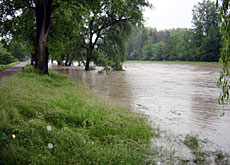
Switzerland’s rivers return to their old ways

Switzerland’s strategy of taming its rivers has caused serious ecological damage and increased the likelihood of flooding, sometimes with catastrophic consequences.
Today, some 100 projects are underway to reverse the mistakes of the past by restoring waterways to their normal meandering routes.
Between 1870 and 1940, Swiss rivers and lakes were subjected to major dam-building and canalisation works.
“In those days, most of the population still worked the land and water courses were rerouted and canalised to combat the danger of flooding and to cultivate swamp areas,” said Ueli Schälchli, who is preparing a new river bed for a stretch of the Limmat near Zurich.
“Once the larger rivers and lakes had been ‘corrected’, almost all other streams and brooks were forced into straitjackets over the past 50 years.”
The country has been paying the price in recent years. In 1999 and 2000, devastating floods killed 20 people and caused SFr1.5 billion in damage.
Storms
“When there’s a storm, the water flows much more quickly downhill in canalised or concreted beds,” explains Andreas Knutti, who is in charge of water projects for the Swiss section of the WWF. “Very little water seeps into the ground, which is what happened before the correction work was undertaken.”
“In recent years floods have become much more frequent. And, with the expected climatic changes, the situation could deteriorate further over the next few decades.”
According to the Swiss environment agency, more than 100 revitalisation projects have been launched throughout Switzerland over the past five years at a cost of SFr200 million. Some have already been completed.
Correcting “corrections”
Most involve “correcting the corrections” of riverbeds. One is underway at the moment in Geroldswil, just outside Zurich. A dozen excavators have been working along the banks of the Limmat since April.
They are preparing a more suitable bed for the river which, in this area, runs as straight as a die, almost like an airport runway.
By November, the waterway will be able to take a more leisurely route for almost a kilometre on its way towards the North Sea.
Experts say the meanders, islands, sandbanks and pools will allow nature to regenerate itself and recreate an ecosystem similar to that of a century ago.
“In order to revive a water course you need space,” explains Schälchli, head of the project in Geroldswil.
Control
“We have to move the banks by a few hundred metres, then excavate, reinforce the ground and, in some cases, carry out some botanical work. But it is the river itself which regains control of the area and re-establishes a natural environment,” he adds.
Usually it takes just a few years for an entire ecosystem to emerge.
The work – involving labourers, engineers and biologists – will cost at least SFr3 million or around SFr3,000 per metre.
Apart from improving the appearance of the river, the “correction” should reduce the risk of flooding.
At the beginning of June, the Limmat burst its banks again in this area. Although not especially serious, the damage caused totalled around SFr5 million.
“Revitalisation of water courses means we can combine economic and ecological advantages,” says Knutti.
Prevention
“[But] first of all, we have to convince the politicians that it is better to invest in prevention rather than damage repair.
“Second, in a country as densely populated as Switzerland, it is not easy to make the necessary land available. Often owners have to be convinced to give up their land in exchange for equivalent plots.”
If they refuse, the law does not provide for expropriation. But the public is generally supportive of such projects.
“Our experience shows us that three-quarters of the population is in favour of revitalising water courses,” says Knutti.
“These oases, where nature is reborn and revived, are appreciated in particular by people who live in regions most heavily disfigured by urbanisation and industrialisation.”
“Popular support increases the closer you get to towns and cities,” Schälchli confirms.
“In the country, where the loss of the natural environment is not felt so acutely, it is more difficult to understand the usefulness of this work aimed at revitalising the rivers”.
swissinfo, Armando Mombelli
Damage caused by landslides and floods have cost an estimated SFr10 billion over the past 30 years.
Floods in 1999 and 2000 alone killed 20 people and caused SFr1.5 billion in damage.
In the past five years, SFr200 million has been approved for revitalising waterways.

In compliance with the JTI standards
More: SWI swissinfo.ch certified by the Journalism Trust Initiative































You can find an overview of ongoing debates with our journalists here . Please join us!
If you want to start a conversation about a topic raised in this article or want to report factual errors, email us at english@swissinfo.ch.